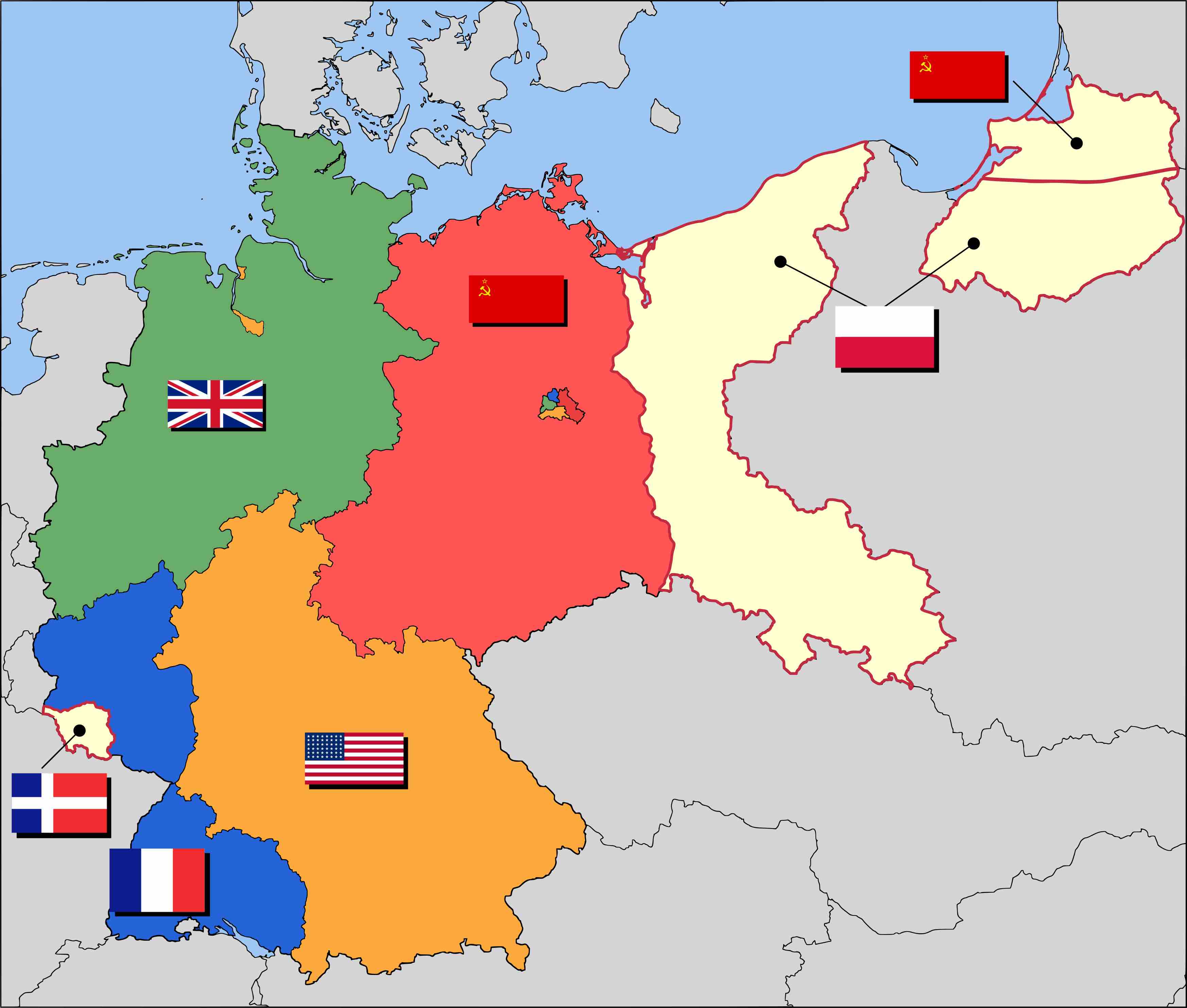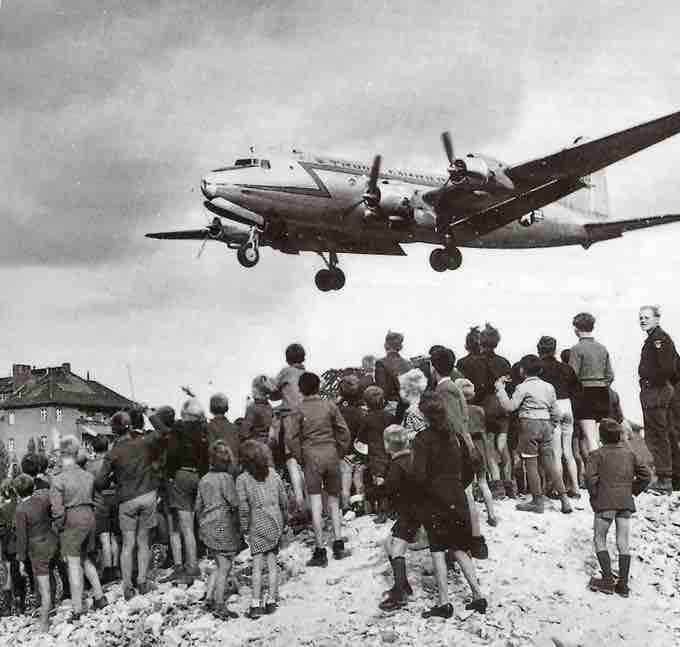Superpower Conflict
The United States and Soviet Union eventually emerged as the two major superpowers after World War II. The 1956 Suez Crisis suggested that Britain, financially weakened by two world wars, could no longer pursue its foreign policy objectives on an equal footing with the new superpowers without sacrificing convertibility of its reserve currency as a central goal of policy.
Despite attempts to create multinational coalitions or legislative bodies (such as the United Nations), it became increasingly clear that the US and Soviet superpowers had very different visions about what the post-war world ought to look like. The US and the Soviet Union opposed each other ideologically, politically, militarily, and economically. The Soviet Union promoted the ideology of communism, which was characterized by a planned economy and a one-party state. In contrast, the United States promoted the ideologies of liberal democracy and the free market.
The division of the world along US-Soviet lines was reflected in the NATO and Warsaw Pact military alliances, respectively. Most of Europe became aligned with either the United States or the Soviet Union. These alliances implied that these two nations were part of a world organized into a bipolar balance of power, in contrast with a previously multipolar world.
Forming the Eastern Bloc
During the opening stages of World War II, the Soviet Union laid the foundation for the Eastern Bloc by directly annexing several countries as Soviet Socialist Republics that were initially ceded to it by Nazi Germany in the Molotov–Ribbentrop Pact. These included eastern Poland, Latvia, Estonia, Lithuania, part of eastern Finland, and eastern Romania. In Asia, the Red Army had overrun Manchuria in the last month of the war, and went on to occupy the large swathe of Korean territory located north of the 38th parallel.
The Eastern European territories liberated from the Nazis and occupied by the Soviet armed forces were added to the Eastern Bloc by converting them into satellite states. The Soviet-style regimes that arose in the satellite states not only reproduced Soviet command economies, but also adopted the brutal methods employed by Joseph Stalin and Soviet secret police to suppress real and potential opposition.
Following the Allies' May 1945 victory, the Soviets effectively occupied Eastern Europe, while strong US and Western allied forces remained in Western Europe. In Allied-occupied Germany, the Soviet Union, United States, Britain and France established zones of occupation and a loose framework for four-power control. Soviet occupation of Eastern bloc states was viewed with suspicion by Western powers, as they saw this occupation as a sign of Soviet willingness to use aggression to spread the ideology of communism.

Post-War Allied Occupation Zones in Germany
Occupation zone borders in Germany, 1947. The main Allied powers established zones of occupation in Germany after World War II.
The Marshall Plan
In early 1947, Britain, France and the United States unsuccessfully attempted to reach an agreement with the Soviet Union for a plan envisioning an economically self-sufficient Germany, including a detailed accounting of the industrial plants, goods and infrastructure already removed by the Soviets. In June 1947, in accordance with the Truman Doctrine, the United States enacted the Marshall Plan, a pledge of economic assistance for all European countries willing to participate, including the Soviet Union. The plan's aim was to rebuild the democratic and economic systems of Europe and to counter perceived threats to Europe's balance of power, such as communist parties seizing control through revolutions or elections. The plan also stated that European prosperity was contingent upon German economic recovery. One month later, Truman signed the National Security Act of 1947, creating a unified Department of Defense, the Central Intelligence Agency (CIA), and the National Security Council (NSC). These would become the main bureaucracies for US policy in the Cold War.
Stalin opposed the Marshall Plan. He had built up the Eastern Bloc protective belt of Soviet controlled nations on his Western border, and wanted to maintain this buffer zone of states and a weakened Germany under Soviet control. Fearing American political, cultural and economic penetration, Stalin eventually forbade Soviet Eastern bloc countries from accepting Marshall Plan aid. Stalin believed that economic integration with the West would allow Eastern Bloc countries to escape Soviet control, and that the US was trying to buy a pro-US re-alignment of Europe. The Soviet Union's alternative to the Marshall plan, which was purported to involve Soviet subsidies and trade with eastern Europe, became known as the Molotov Plan.
The Berlin Blockade
As part of the economic rebuilding of Germany, in early 1948, representatives of a number of Western European governments and the United States announced an agreement for a merger of western German areas into a federal governmental system. In addition, in accordance with the Marshall Plan, they began to re-industrialize and rebuild the German economy, including the introduction of a new Deutsche Mark currency to replace the old Reichsmark currency that the Soviets had debased.
Shortly thereafter, Stalin instituted the Berlin Blockade (24 June 1948 – 12 May 1949), one of the first major crises of the Cold War, preventing food, materials and supplies from arriving in West Berlin. The Soviet Union blocked the Western Allies' railway, road, and canal access to the sectors of Berlin under Western control. The Soviets offered to drop the blockade if the Western Allies withdrew the newly introduced Deutsche mark from West Berlin.
In response, the Western Allies organized the Berlin airlift to carry supplies to the people of West Berlin, a difficult feat given the city's population. Aircrews from the United States Air Force, the British Royal Air Force, the Royal Canadian Air Force, the Royal Australian Air Force, the Royal New Zealand Air Force, and the South African Air Force:338 flew over 200,000 flights in one year, providing to the West Berliners up to 8,893 tons of necessities each day, such as fuel and food. The Soviets did not disrupt the airlift for fear this might lead to open conflict.
By the spring of 1949, the airlift was clearly succeeding, and by April it was delivering more cargo than had previously been transported into the city by rail. On 12 May 1949, the USSR lifted the blockade of West Berlin. The Berlin Blockade served to highlight the competing ideological and economic visions for postwar Europe.

Berlin Airlift
Berliners watch an aircraft take part in the Berlin Airlift, which was a successful attempt to circumvent the Soviet blockade of non-Soviet Berlin. The Berlin Blockade and the tensions surrounding it marked the beginning of the Cold War.